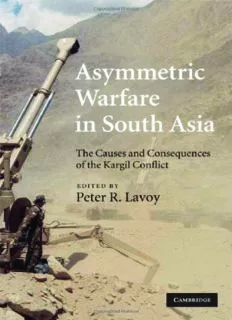
Asymmetric warfare in South Asia: the causes and consequences of the Kargil Conflict PDF
Preview Asymmetric warfare in South Asia: the causes and consequences of the Kargil Conflict
Asymmetric Warfare in South Asia The1999conflictbetweenIndiaandPakistannearthetownofKargilin contested Kashmir was the first military clash between two nuclear- armed powers since the 1969 Sino-Soviet war. Kargil was a landmark eventnotbecauseofitsdurationorcasualties,butbecauseitcontaineda veryreal risk ofnuclear escalation. Until theKargil conflict, academic and policy debates over nuclear deterrence and proliferation occurred largelyonthetheoreticallevel.Thisdeepanalysisoftheconflictoffers scholars and policymakers a rare account of how nuclear-armed states interactduringamilitarycrisis.WrittenbyanalystsfromIndia,Pakistan, and the United States, this unique book draws extensively on primary sources, including unprecedented access to Indian, Pakistani, and US governmentofficialsandmilitaryofficerswhowereactivelyinvolvedin theconflict.Thisisthefirstrigorousandobjectiveaccountofthecauses, conduct,andconsequencesoftheKargilconflict. peter r. lavoy is the Deputy Director of National Intelligence for Analysis. Previously he served as Director of the Center for Contemporary Conflict at the Naval Postgraduate School and Director of Counterproliferation Policy in the Office of the Secretary ofDefense. Asymmetric Warfare in South Asia The Causes and Consequences of the Kargil Conflict Editedby Peter R. Lavoy cambridge university press Cambridge,NewYork,Melbourne,Madrid,CapeTown,Singapore, SãoPaulo,Delhi,Dubai,Tokyo CambridgeUniversityPress TheEdinburghBuilding,CambridgeCB28RU,UK PublishedintheUnitedStatesofAmericabyCambridgeUniversityPress, NewYork www.cambridge.org Informationonthistitle:www.cambridge.org/9780521767217 ©CambridgeUniversityPress2009 Thispublicationisincopyright.Subjecttostatutoryexception andtotheprovisionsofrelevantcollectivelicensingagreements, noreproductionofanypartmaytakeplacewithout thewrittenpermissionofCambridgeUniversityPress. Firstpublished2009 PrintedintheUnitedKingdomattheUniversityPress,Cambridge AcataloguerecordforthispublicationisavailablefromtheBritishLibrary ISBN978-0-521-76721-7Hardback CambridgeUniversityPresshasnoresponsibilityfor thepersistenceoraccuracyofURLsforexternalor third-partyinternetwebsitesreferredtointhisbook, anddoesnotguaranteethatanycontentonsuch websitesis,orwillremain,accurateorappropriate. Contents Listofmapsandtables pageix Listofcontributors x Preface xiii Listofabbreviationsandacronyms xv 1 Introduction:theimportanceoftheKargilconflict 1 PETER R. LAVOY Whythisstudymatters 2 Controversiesclarified 5 TheKargilconflictincontext 14 EnduringrivalryinSouthAsia 23 Thenuclearrevolutionreconsidered 29 Part1 Causesandconductoftheconflict 39 2 ThestrategiccontextoftheKargilconflict:aPakistani perspective 41 ZAFAR IQBAL CHEEMA Introduction 41 Thehistoricalrationale 42 FCNAandtheNorthernAreas 49 Contemporaryrationale:theSiachenGlacier 52 TheKashmiruprising:theLineofControlandtheNeelumValley 55 Pakistan’sofficialversion 57 PotentialobjectivesoftheKargilconflict 61 Conclusion 62 3 Pakistan’smotivationsandcalculationsfortheKargil conflict 64 FEROZ HASSAN KHAN, PETER R. LAVOY, AND CHRISTOPHER CLARY Ahistoryofgrievance 68 Restoringhonor 74 v vi Contents TheimmediatecauseofKargil 80 Anewchainofcommand 83 Assumptionsandmiscalculations 86 Conclusion 90 4 MilitaryoperationsintheKargilconflict 92 JOHN H. GILL Preludetoconflict 93 Buildup:localandnational 105 Indiancounteroffensive 114 Combatoperations:anassessment 120 Observations 123 5 Americandiplomacyandthe1999KargilSummit atBlairHouse 130 BRUCE RIEDEL Prologue 130 Introduction 132 KargilandKashmir 132 Nawazcallsforhelp 135 The4thdawns 137 Aftermath:newdealinNewDelhi,coupinIslamabad 141 6 Kargil:thenucleardimension 144 TIMOTHY D. HOYT PreludetoKargil:theMay1998tests 146 Kargilasanuclearcrisis 155 Post-Kargilinteraction:thenucleardimension 161 Conclusion 167 7 WhyKargildidnotproducegeneralwar:thecrisis- managementstrategiesofPakistan,India,andthe UnitedStates 171 PETER R. LAVOY SouthAsia’snuclearrevolution 172 Pakistan’scalculations 177 India’sconflict-terminationstrategy 190 Internationaldiplomacy 197 Conclusion 204 Part2 Consequencesandimpactoftheconflict 207 8 Surpriseatthetopoftheworld:India’ssystemicand intelligencefailure 209 JAMES J. WIRTZ AND SURINDER RANA Contents vii Thetheoryofsurprise 211 ThefaitaccompliatKargil 215 Planningthefaitaccompli:theviewfromPakistan 216 Ripeforsurprise:theviewfromIndia 219 ProblemswithIndia’sintelligenceorganizations 220 Conclusion 228 9 MilitantsintheKargilconflict:myths,realities,and impacts 231 C. CHRISTINE FAIR Background:originsofthemyth 231 Pakistan’sinternaldynamics 236 ImpactintheValleyofKashmir 244 ImpactonPakistan’sforeignrelations 248 Conclusion 256 10 TheimpactoftheKargilconflictandKashmironIndian politicsandsociety 258 PRAVEEN SWAMI Popularculture 259 TheKargilelection 263 TheKargilwarandtheconflictinKashmir 270 Conclusion:war,terrorists,andtemples 277 11 TheKargilconflict’simpactonPakistanipoliticsand society 280 SAEED SHAFQAT ThePakistaniprintmedia’sKargil 282 Thedomesticpoliticalimpact 289 Thereligiouspartiesoutflankthemainstream 290 Politicalmanagementandmismanagement 296 Thecoupanditsaftermath 304 Conclusion 306 Part3 Lessonslearned 309 12 ThelessonsofKargilaslearnedbyIndia 311 RAJESH M. BASRUR Organizationallessons 313 Strategiclessons 320 Conclusion:lessonswelllearned? 328 13 ThelessonsofKargilaslearnedbyPakistan 333 HASAN-ASKARI RIZVI MilitarylearninginSouthAsia 334 viii Contents Misperceivingothers:Pakistaniperceptionsofinternationalresponse 337 Theharshspotlight 340 Operationallessons 346 Assessmentoftheconflict 349 Conclusion:hasPakistanlearned? 350 14 TheKargilcrisis:lessonslearnedbytheUnitedStates 353 RODNEY W. JONES AND JOSEPH MCMILLAN LessonsforUSrelationswithIndiaandPakistan 354 Lessonsfornuclearstabilityandnonproliferationpolicy 359 Lessonsforfutureengagement 365 Conclusion 373 15 Kargil,deterrence,andinternationalrelationstheory 377 ROBERT JERVIS Introduction 377 Natureofthepuzzle 379 RoutestoKargil 381 Surprise 387 Nuclearweapons,nuclearwars 388 Conclusion 396 Index 398 Maps and tables Maps 1.1 JammuandKashmir page17 2.1 Indianingressafter1972andallegedPakistaniincursion 50 2.2 UnoccupiedareasalongtheLoC 59 4.1 Mushkoh,Dras,andKaksarsectors 99 4.2 Bataliksector 100 4.3 ChorbatLaandTurtok(Hanif)sectors 101 Tables 1.1 TheKargilconflict’simplicationsfornuclear-deterrence theory 36 4.1 IndianandPakistaniforcesintheKargilconflict 127 10.1 Resultsinthe1998and1999GeneralElectionsformajor parties 265 10.2 Votingpatternsinfourkeystates,GeneralElections1998and 1999 266 10.3 Anoverviewofthe“pro-active”policy 273 11.1 Partyshareofvotes:all-PakistanNationalAssemblyelections 291 ix
Description: